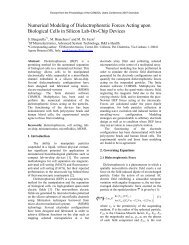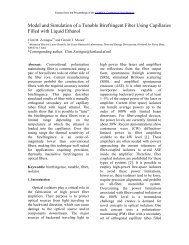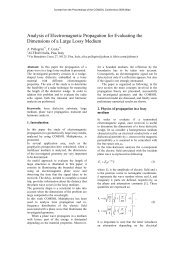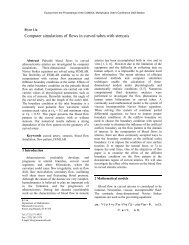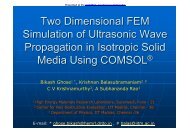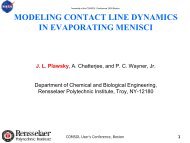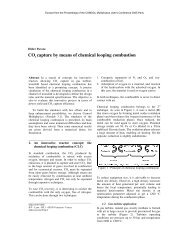Mathematical Modeling of Nanomaterials - COMSOL.com
Mathematical Modeling of Nanomaterials - COMSOL.com
Mathematical Modeling of Nanomaterials - COMSOL.com
Create successful ePaper yourself
Turn your PDF publications into a flip-book with our unique Google optimized e-Paper software.
Excerpt from the Proceedings <strong>of</strong> the <strong>COMSOL</strong> Multiphysics User's Conference 2005 Frankfurt<br />
multiscale model. We applied a hybrid scheme which is based on Maxwell and Navier-<br />
Stokes equations to paramagnetic liquids with particles <strong>of</strong> the size <strong>of</strong> 10nm (ferr<strong>of</strong>luids). For<br />
a considered area <strong>of</strong> the body, the Maxwell equations for the static magnetic case were<br />
solved. The vector potential was then coupled to a liquid flow problem described by the<br />
Navier-Stokes equations by a volume force acting on the magnetic liquid. Time-dependent<br />
boundary conditions were used to describe the systolic blood flow regime. The system <strong>of</strong><br />
coupled partial differential equations was solved by the finite element method on adaptive<br />
meshes. For a representative geometry which can be extracted by medical imaging, our<br />
hybrid model allowed the study <strong>of</strong> the hydrodynamics <strong>of</strong> the magnetic liquid. Moreover, our<br />
model is open for an embedding <strong>of</strong> a nanoscale model which represents the particle<br />
dynamics. It is concluded that the proposed model is a prerequisite for the optimal<br />
<strong>com</strong>putational choice <strong>of</strong> the free parameters <strong>of</strong> magnetic liquids and the external magnetic<br />
field for in vivo applications.<br />
1.2.2 Model equations<br />
Maxwell‘s Equations for the Static Case:<br />
∇ × H = J ∇ ⋅B = 0<br />
Using a constitutive relation: B = µ ( H + M)<br />
These equations can be <strong>com</strong>bined to:<br />
−1<br />
∇× ( µ ∇× A − M)<br />
= J<br />
Where A denotes a magnetic vector potential, B is the Magnetic Flux density, M the<br />
magnetization vector, J is the current density vector and H is the magnetic field vector.<br />
The magnetization (gamma) <strong>of</strong> the ferr<strong>of</strong>luid is given by<br />
⎛<br />
⎜<br />
⎛ −<br />
γ =<br />
α arctan⎜<br />
βµ<br />
⎝ ⎝<br />
1<br />
∂A ( x,<br />
y)<br />
⎞ ⎛ ∂ ⎞⎞<br />
−1<br />
A(<br />
x,<br />
y)<br />
⎟,<br />
α arctan⎜<br />
βµ ⎟⎟<br />
∂x<br />
⎠<br />
⎝ ∂y<br />
⎠⎠<br />
In<strong>com</strong>pressible Navier-Stokes Equation with Magnetic Force Term<br />
∂u<br />
ρ − ∇ ⋅<br />
∂t<br />
T<br />
( ∇u<br />
+ ( ∇u)<br />
) + ρ(<br />
u ⋅∇)<br />
u + ∇p<br />
= F<br />
m<br />
+ F<br />
g<br />
1.2.3 FEMLAB <strong>Modeling</strong><br />
Here we show two simulations, Fig. 9 is based on the macroscale model already described.<br />
Fig. 10 shows a particle scale simulation, which is in development. It is noticeable that above<br />
a time t, the magnetic nanoparticle carriers in the flow are disturbed in the vicinity <strong>of</strong> a<br />
magnetic field.



![[PDF] Microsoft Word - paper.docx - COMSOL.com](https://img.yumpu.com/50367802/1/184x260/pdf-microsoft-word-paperdocx-comsolcom.jpg?quality=85)
